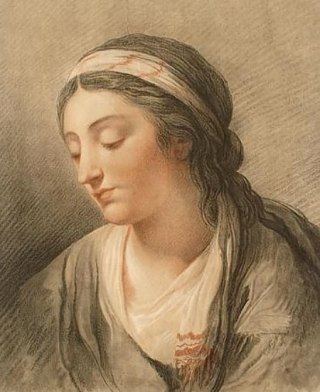Marie-Jeanne Riccoboni (October 25, 1713 in Paris - December 7, 1792 in Paris), whose maiden name was Laboras de Mezieres, was a French actress and novelist.
She was born in Paris in 1713.
In 1735 she married Antoine Francois Riccoboni, a comedian and dramatist, from whom she soon separated. She herself was an actress and had moderate success on the stage.
Madame Riccoboni's work is among the most eminent examples of the "sensibility" novel; among the parallels cited in English literature are works by Laurence Sterne and Samuel Richardson. A still nearer parallel may be found in the work of Henry Mackenzie.
She obtained a small pension from the crown, but the Revolution deprived her of it, and she died in Paris on December 7, 1792 in great poverty.
For more biographical details, see the Web site of the Association Riccoboni (mainly in French).
Apart from authoring the works listed below, Riccoboni was the editor of a periodical, L'Abeille (1761), wrote a novel (1762) on the subject of Fielding's Amelia, and supplied in 1765 a continuation (but not the conclusion sometimes erroneously ascribed to her) of Marivaux's unfinished Marianne. Riccoboni also corresponded with such luminaries as Pierre Choderlos de Laclos, author of Les Liaisons Dangeureuses, as well as David Hume and the theater celebrity David Garrick (see J.C. Nicholls, ed. Madame Riccoboni’s letters to David Hume, David Garrick, and Sir Robert Liston : 1764-1783, Oxford: The Voltaire Foundation, 1976).
Some of her better known works are:
Lettres de mistriss Fanni Butlerd (1757)the remarkable Histoire du marquis de Cressy (1758)Lettres de Milady Juliette Catesby (1759), an epistolary novel appreciated by Voltaire and translated into English by Frances Brooke in 1760l'Histoire d'Ernestine (1765), which La Harpe thought her masterpiecethree series of Lettres in the names of:Adelaide de Dammartin (comtesse de Sancerre) (2 vol., 1766)Elizabeth Sophie de Valliere (2 vol., 1772)Milord Rivers (2 vol., 1776)For a more complete survey of literature on Mme Riccoboni, see the bibliography by the Association Riccoboni.
Jan Herman, Kris Peeters and Paul Pelckmans, eds. Mme Riccoboni, romanciere, epistoliere, traductrice, colloque de l'universite de Louvain-Anvers (2006) Louvain; Paris: Dudley, 2007.Annie Cointre, Florence Lautel-Ribstein, Annie Rivara, eds. La traduction du discours amoureux (1660-1830). Metz: CETT, 2006. (Two papers pertain to Riccoboni: Jan Herman and Beatrijs Vanacker, 'Madame Riccoboni travestie par Casanova : de nouveaux habits pour Juliette Catesby', and Raeleen Chai-Elsholz, 'Textual Allusions and Narrative Voice in the Lettres de Milady Juliette Catesby and its English Translation'.)Brigitte Diaz and Jurgen Siess, eds. L'epistolaire au feminin, correspondances de femmes, colloque de Cerisy-la-Salle (2003). Presses universitaires de Caen, 2006.Suzan Van Dijk, 'Fictions revues et corrigees : Marie-Jeanne Riccoboni en face de la critique contemporaine', in Journalisme et fiction au 18e siecle, eds. Malcolm Cook and Annie Jourdan. Bern: Peter Lang, 1999.Susan Sniader Lanser, Fictions of Authority. Women Writers and Narrative Voice. Ithaca, NY: Cornell University Press, 1992. (See esp. chapter 2: 'The Rise of the Novel, The Fall of the Voice: Juliette Catesby's Silencing', and chapter 3: 'In a Class by Herself: Self-Silencing in Riccoboni's Abeille'.)Elizabeth Heckendorn Cook, 'Going Public: The Letter and the Contract in Fanni Butlerd', Eighteenth-Century Studies 24.1 (Fall 1990): 21-45.Joan Hinde Stewart, 'Sex, Text, and Exchange: Lettres neuchateloises and Lettres de Milady Juliette Catesby', Eighteenth-Century Life 13.1 (Feb. 1989): 60-68.Andree Demay, Marie-Jeanne Riccoboni : ou De la pensee feministe chez une romanciere du XVIIIe siecle. Paris: La Pensee Universelle, 1977.Joan Hinde Stewart, The Novels of Mme Riccoboni. Chapel Hill: North Carolina Studies in the Romance Languages and Literatures, 1976.Kenneth R. Umland, Madame Riccoboni et Diderot : un debat sur l’art theatral au dix-huitieme siecle. [s.l.s.n.], 1975.Emily A. Crosby, Une romanciere oubliee, Mme Riccoboni : sa vie, ses œuvres, sa place dans la litterature anglaise et francaise du XVIIIe siecle. Paris: F. Rieder, 1924; Geneva: Slatkine Reprints, 1970.
